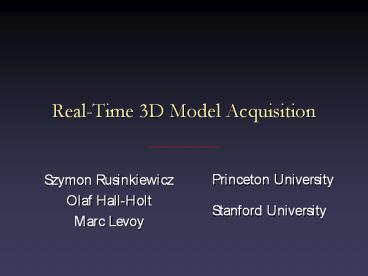Real-Time 3D Model Acquisition PowerPoint PPT Presentation
Title: Real-Time 3D Model Acquisition
1
Real-Time 3D Model Acquisition
Princeton University Stanford University
- Szymon Rusinkiewicz
- Olaf Hall-Holt
- Marc Levoy
2
3D Scanning
3
Possible Research Goals
- Low noise
- Guaranteed high accuracy
- High speed
- Low cost
- Automatic operation
- No holes
4
3D Model Acquisition Pipeline
3D Scanner
5
3D Model Acquisition Pipeline
3D Scanner
6
3D Model Acquisition Pipeline
3D Scanner
7
3D Model Acquisition Pipeline
3D Scanner
8
3D Model Acquisition Pipeline
3D Scanner
9
3D Model Acquisition Pipeline
3D Scanner
10
3D Model Acquisition Difficulties
- Much (often most) time spent on last 20
- Pipeline not optimized for hole-filling
- Not sufficient just to speed up scanner must
design pipeline for fast feedback
11
Real-Time 3D Model Acquisition
12
Real-Time 3D Model Acquisition Pipeline
3D Scanner
Alignment
View Planning
Human
Merging
Done?
Display
13
Real-Time 3D Model Acquisition Pipeline
3D Scanner
View Planning
Challenge Real Time
Done?
Display
14
Real-Time 3D Model Acquisition Pipeline
3D Scanner
Alignment
View Planning
Part I Structured-LightTriangulation
Merging
Done?
Display
15
Real-Time 3D Model Acquisition Pipeline
3D Scanner
Alignment
View Planning
Part II Fast ICP
Merging
Done?
Display
16
Real-Time 3D Model Acquisition Pipeline
3D Scanner
Alignment
View Planning
Part III Voxel Grid
Merging
Done?
Display
17
Triangulation
Object
- Project laser stripe onto object
18
Triangulation
Object
Laser
(x,y)
- Depth from ray-plane triangulation
19
Triangulation
- Faster acquisition project multiple stripes
- Correspondence problem which stripeis which?
20
Continuum of Triangulation Methods
Slow, robust
Fast, fragile
21
Time-Coded Light Patterns
- Assign each stripe a unique illumination
codeover time Posdamer 82
Time
Space
22
Codes for Moving Scenes
- Assign time codesto stripe boundaries
- Perform frame-to-frametracking of
correspondingboundaries - Propagate illumination history
- Hall-Holt Rusinkiewicz, ICCV 2001
23
Designing a Code
- Want many features to tracklots of
black/white edges at each frame - Try to minimize ghosts WW or BB boundaries
that cant be seen directly
24
Designing a Code
0000
1101
1010
0111
1111
0010
1000
0101
1011
0110
0001
1100
0100
1001
0011
1110
Hall-Holt Rusinkiewicz, ICCV 2001
25
Implementation
- Pipeline
- DLP projector illuminates scene _at_ 60 Hz.
- Synchronized NTSC camera captures video
- Pipeline returns range images _at_ 60 Hz.
Project Code
Capture Images
Find Boundaries
Match Boundaries
Decode
Compute Range
26
Real-Time 3D Model Acquisition Pipeline
3D Scanner
Alignment
View Planning
Part II Fast ICP
Merging
Done?
Display
27
Aligning 3D Data
- This range scanner can be used for anymoving
objects - For rigid objects, range images can be aligned to
each other as object moves
28
Aligning 3D Data
- ICP (Iterative Closest Points) for each point on
one scan, minimize distance to closest point on
other scan
29
Aligning 3D Data
- and iterate to find alignment
- Iterated Closest Points (ICP) Besl McKay 92
30
ICP in the Real-Time Pipeline
- Potential problem with ICP local minima
- In this pipeline, scans close together
- Very likely to converge to correct (global)
minimum - Basic ICP algorithm too slow ( seconds)
- Point-to-plane minimization
- Projection-based matching
- With these tweaks, running time
millisecondsRusinkiewicz Levoy, 3DIM 2001
31
Real-Time 3D Model Acquisition Pipeline
3D Scanner
Alignment
View Planning
Part III Voxel Grid
Merging
Done?
Display
32
Merging and Rendering
- Goal visualize the model well enoughto be able
to see holes - Cannot display all the scanned data accumulates
linearly with time - Standard high-quality merging methodsprocessing
time 1 minute per scan
33
Merging and Rendering
34
Merging and Rendering
35
Merging and Rendering
36
Merging and Rendering
37
Merging and Rendering
- Point rendering, using accumulated normals for
lighting
38
Example Photograph
18 cm.
39
Result
40
Postprocessing
- Real-time display
- Quality/speed tradeoff
- Goal let user evaluate coverage, fill holes
- Offline postprocessing for high-quality models
- Global registration
- High-quality merging (e.g., using VRIP Curless
96)
41
Postprocessed Model
42
Recapturing Alignment
43
Summary
- 3D model acquisition pipeline optimized for
obtaining complete, hole-free models - Use humans time most efficiently
- Pieces of pipeline selected for real-time use
- Structured-light scanner for moving objects
- Fast ICP variant
- Simple grid-based merging, point rendering
44
Limitations
- Prototype noisier than commercial systems
- Could be made equivalent with careful engineering
- Ultimate limitations on quality focus, texture
- Scan-to-scan ICP not perfect ? alignment drift
- Due to noise, miscalibration, degenerate geometry
- Reduced, but not eliminated, by anchor scans
- Possibly combine ICP with separate trackers
45
Future Work
- Faster scanning
- Better stripe boundary tracking
- Multiple cameras, projectors
- High-speed cameras, projectors
- Application in different contexts
- Cart- or shoulder-mounted for digitizing rooms
- Infrared for imperceptibility
46
Acknowledgments
- Collaborators
- Li-Wei He
- James Davis
- Lucas Pereira
- Sean Anderson
- Sponsors
- Sony
- Intel
- Interval

